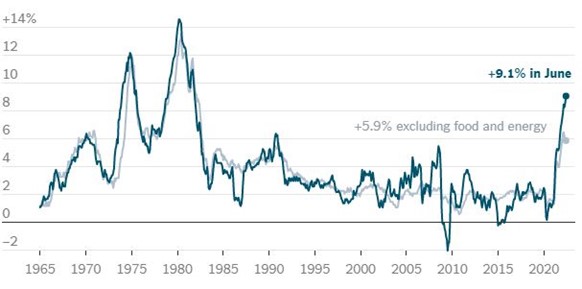The Silver Lining Amidst a Changing Market
Published Expert Article
– by Jake Waxter
Associate Advisor at Pinnacle Real Estate Advisors
As of July 27th, CPI rose 9.1% year over year even after the largest rate hike since 1994. Simply put, this is not a good sign for the economy as inflation continues to be persistent even through significant rate hikes. At the July meeting, the Federal Reserve announced that they plan to raise the target federal funds Rate another 75 basis points bringing the target rate to 2.25 to 2.5%. The hawkish approach by the federal reserve are actions taken in order to slow the economy and curb inflation. The chart from New York Times below shows how inflation today compares to the previous 60 years.

Over the course of the past four months, the Federal Reserve has stated that their main goal is to attempt to curb inflation back down to 2%. One of the ways they plan to achieve that goal is via quantitative tightening to slow economic activity. Since March, the Federal Reserve has raised the target federal funds rate multiple times including two 75 basis point hikes. They plan to continue to periodically raise rates for the rest the calendar year in 2022. However, as Powell and the Fed mentioned in July 27th press conference, their decisions will be determined on how the next few months go in relation to CPI and the overall economies performance. If they need to make another significant jump with rates in order to slow the economy and curtail inflation, they have mentioned that they will do so. Since April, it has been their aim to make the target funds rate 3.5-3.8% by the end of the calendar year in order to slow the US economy. They have maintained their outlook, but they have taken a hawkish approach in order to expedite this process and get there quicker. Due to these quick and significant changes in the world, it has caused some shock within our market. What does this mean for CRE, but specifically Multifamily Properties in the Denver Metro Area?
As mentioned, the federal funds rate today sits at 2.5% with an anticipated target of 3.5% to 3.8% by the end of the year. The reason the fed fund rate matters not only to multifamily investors, but real estate investors of all asset classes is because the federal funds rate is a major indicator for where interest rates will be. As we look ‘under the hood’, investors compare capitalization rates with interest rates and the spreads between the two. Over the course of the past couple of years, the spread between cap rates and interest rates have shrunk because of the demand for multifamily in the Denver metro area. However, as the Federal Reserve continues to try to curb inflation and slow the economy, they are raising the target federal fund rate which increases the cost of debt for investors. In turn, the market is seeing a speedbump in the volume of transactions as these changes have been so significant over such a short amount of time. Because of these changes, there is a disconnect between owners and investors. Owners want to achieve yesterday’s prices and investors want prices that reflect the cost of today’s debt. Until the market reaches an equilibrium and has less significant changes, the market will see less transaction volume. In addition to rate changes, lenders have also become more conservative as markets have shifted indicating a recessionary environment. Lenders have shifted LTVs from 75% just a few months ago to 60% which requires investors to bring more capital for a down payment.
Throughout all of this turmoil and uncertainty, fortunately there are plenty of silver linings in our market and asset type. What we do know is that Multifamily as an investment strategy is somewhat insulated to outside changes. For the past five years, we have seen a significant presence with capital outside of Colorado coming from major cities across the US and even internationally. They have flooded the Denver market making it extremely competitive driving up values. Furthermore, for the past five years Denver has been in the top 10 for America’s hottest job markets. Job and wage growth both play a significant factor as we have seen an increase in rents by up to 20% across some portfolios this year. Through a potential recession, we will always see a need for Multifamily. Not to mention, it is one of the most expensive cities to purchase a home, creating an even larger population of renters. Lastly, there will always be people that will need places to live. During 2020 and throughout a global pandemic, there were renters. Today, there are renters and tomorrow there will be renters. People are more cautious with their financing during times of uncertainty; they look to places where they can save, not spend. So again, Multifamily investors are fortunate that we are somewhat insulated from outside pressures. People move to Colorado in order to live a lifestyle that is incredibly unique compared other parts of the country and investors across United States and world recognize that.
Featured in CREJ’s August 2022 Multifamily Properties Quarterly
